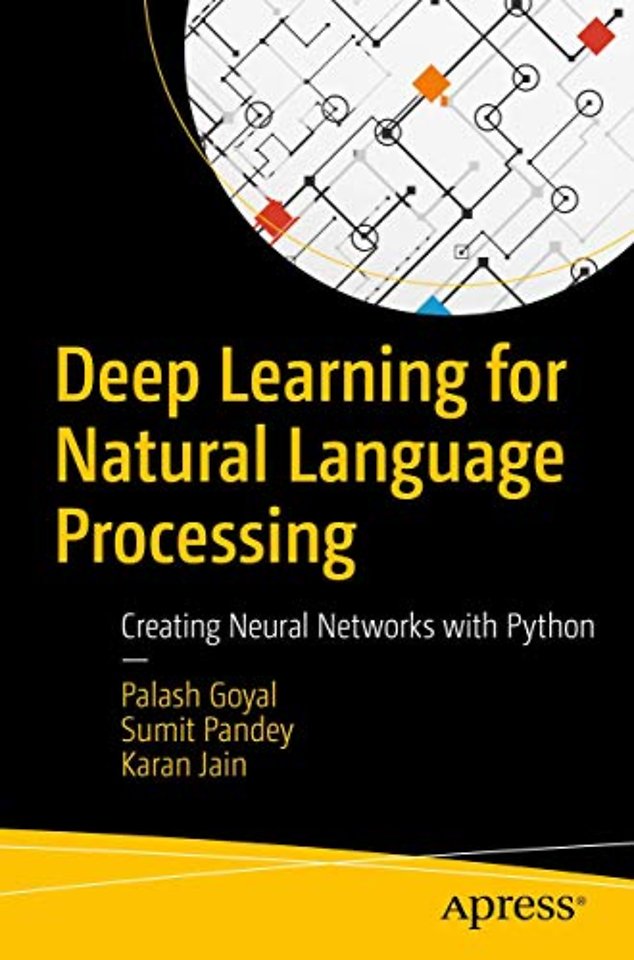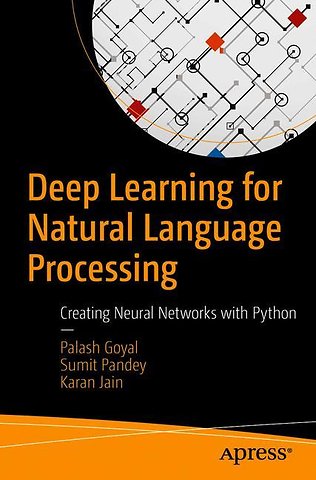Deep Learning for Natural Language Processing
Creating Neural Networks with Python
Paperback Engels 2018 9781484236840Samenvatting
Discover the concepts of deep learning used for natural language processing (NLP), with full-fledged examples of neural network models such as recurrent neural networks, long short-term memory networks, and sequence-2-sequence models.
You’ll start by covering the mathematical prerequisites and the fundamentals of deep learning and NLP with practical examples. The first three chapters of the book cover the basics of NLP, starting with word-vector representation before moving onto advanced algorithms. The final chapters focus entirely on implementation, and deal with sophisticated architectures such as RNN, LSTM, and Seq2seq, using Python tools: TensorFlow, and Keras. Deep Learning for Natural Language Processing follows a progressive approach and combines all the knowledge you have gained to build a question-answer chatbot system.
This book is a good starting point for people who want to get started in deep learning for NLP. All the code presented in the book will be available in the form of IPython notebooks and scripts, which allow you to try out the examples and extend them in interesting ways.
What You Will Learn
-Gain the fundamentals of deep learning and its mathematical prerequisites
-Discover deep learning frameworks in Python
-Develop a chatbot
-Implement a research paper on sentiment classification
Who This Book Is For
Software developers who are curious to try out deep learning with NLP.
Specificaties
Lezersrecensies
Inhoudsopgave
Chapter 2: Word Vector representationsChapter Goal: Introduction of basic and advanced word vector representationNo of pages: 50-60Sub - Topics 1. Overview of Simple Word Vector representations: word2vec, Glove2. Advanced word vector representations: Word Representations via Global Context and Multiple Word Prototypes3. Evaluation methods for unsupervised word embedding
Chapter 3: Neural Networks and Back Propagation Chapter Goal: Neural Networks for named entity recognitionNo of pages: 50-60Sub - Topics: 1. Learning Representations by back propagating the errors2. Gradient checks, over-fitting, regularization, activation functions
Chapter 4: Recurrent neural networks, GRU, LSTM, CNNChapter Goal: Deep Learning architectures like RNN, CNN, LSTM, and CNN in great details with proper examples of eachNo of pages: 70-80Sub - Topics: 1. Recurrent neural network based language model2. Introduction of GRU and LSTM3. Recurrent neural networks for different tasks4. CNN for object identification
Chapter 5: Developing a ChatbotChapter Goal: Chatbots are artificial intelligence systems that we interact with via text or voice interface. Our aim is to develop and deploy a Facebook messenger Chatbot.No of pages: 50-60Sub - Topics: 1. Development of a simple closed context Chatbot2. Deployment using free server “Heroku”3. Integrating Seq2seq model with the Chatbot4. Integrating Image Identification model with the ChatbotChapter 6: Interaction of Reinforcement Learning and ChatbotChapter Goal: Detailed explanation of the Reinforcement Learning concept and one of the prevalent case studies/research paper on Reinforcement Learning applications for ChatbotNo of pages: 20-30Sub - Topics: 1. Introduction to Reinforcement Learning2. Present applications of Reinforcement Learning for Chatbot3. Detailed explanation of one of the research papers on applications of Reinforcement Learning for Chatbot
Anderen die dit boek kochten, kochten ook
Rubrieken
- advisering
- algemeen management
- coaching en trainen
- communicatie en media
- economie
- financieel management
- inkoop en logistiek
- internet en social media
- it-management / ict
- juridisch
- leiderschap
- marketing
- mens en maatschappij
- non-profit
- ondernemen
- organisatiekunde
- personal finance
- personeelsmanagement
- persoonlijke effectiviteit
- projectmanagement
- psychologie
- reclame en verkoop
- strategisch management
- verandermanagement
- werk en loopbaan







